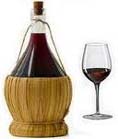
Home...> Articles 6...> Slow Roasting And Spit Roasting
|
|
Slow Roasting And Spit Roasting
|
|
|
Discover how slow roasting and spit roasting meats can improve the flavour. Through research into providing food at budget cost, it has been discovered that there is much less shrinkage by slow roasting meat (the oven is set at 350F (175C) Mark 4 for pork, and at 325F (160C) Mark 4 for all other meats); and now that beef particularly is so expensive it is worthwhile to experiment with this method and to benefit from the information obtained.
Slow Roasting information:
When slow roasting, the only way to ensure that the meat is fully cooked in the centre is to use a meat thermometer. Remember that the thermometer must be inserted into the thickest part of the meat and must never touch the bone, nor rest on the fat, and that the times given in recipes may vary with the size and shape of the joint, and also the amount of fat.
Joints on the bone must always be set on a rack, fat side uppermost, in the roastin tin. It is not necessary to add extra fat. Boned and rolled joints, or those cut from boneless meat, should be spread with a little good dripping and set on a rack in the tin in the same way. There is no need to baste, but they should be turned half way through the cooking.
It is now possible for many more people to spit rioast at home, and electrically operated rotating spits do give an almost exact copy of the old spit roast before an open fire. This method is more like slow roasting, the shrinkage is less, and the flavour is particularly fine as the outside fat develops such a good flavour. In fact, this is the only way to roast a joint of topside, a small lean joint which tends to become hard on the outside when oven roasted.
It is importannt that meat to be spit roasted is at room temperature, so remove it from the refrigerator 2 hours before cooking.
Joints with a cut surface are cooked on a very high heat until the meat just begins to take colour. The heat should then be turned quite low, and the meat is cooked at black heat (ie. not radiant heat) until it is tender. Brush the joint with dripping from time to time during the cooking.
Spit Roasting Guide
Beef:
The cut surface of the joint must always be exposed to the heat in order to seal it and retain the juices. In a joint of wing rib or sirloin the spit should be inserted in such a position that it does not touch the bone, so that the fat and both sides of the lean of the meat are exposed in turn as the joint rotates, If the spit touches the bone it upsets the distribution of heat or may stop it altogether.
Lamb:
A leg of lamb can be spit roasted but particular care must be taken in inserting the spit because of the position of the bone. A shoulder of lamb should be fully or partially boned.
Pork:
Joints cut from the leg should be boned and stuffed, but remeber that the stuffing will swell, so it is wise to put in only the very minimum amount and secure it well by sewing up with a trussing needle and thread. Shoulder cuts, providing they have been removed from the bone, are suitable for spit roasting, but a whole leg would be too large.
Bacon:
A joint of boiling bacon is best simmered in the usual way and then finished on the spit at black heat for about 1 hour with a sugar or syrup glaze.
Hares and rabbits:
For the best flavour, and to prevent the flesh from drying, wrap in larding bacon. Start them on the spit at black heat., and keep at this for full cooking time.
Poultry:
Start and continue cooking poultry at black heat, basting from time to time with melted butter, oil or dripping.
Why not give slow roasting and spit roasting a try?
Read more Italian traditional food related articles here
- cook
- italian
- fish
- recipe
- meat
- food
- dish
- bread
- recipes
- sauce
- dessert
- cooking
- cheese
- herbs
- italian traditional food
- traditional
- pasta
- traditional food
- olive oil
- meal

Copyright © 2009 - . All Rights Reserved Worldwide. Italian Traditional Food
You may not reprint articles from this website without the written permission of the site owner.
Disclaimer: Articles on this Website are provided for information purposes only. Italiantraditionalfood.com does not accept any responsibility or liability for the use or misuse of the article content on this site or reliance by any person on the site's contents.
|

Latest Articles
|
|
COMMENTS 'Great recipes and a great site...' 'At long last, a recipe site that delivers good basic food...' 'Tasty and easy to make recipes. What more can you ask for?...' 'Please keep on providing these rustic recipes as I enjoyed them very much....' 'Not only some great recipes but also some great articles. Thanks." 'What a good idea to provide these recipes. Keep up the good work.' 'Lots of very intresting articles on all aspects of the Italian lifestyle...' 'Wishing you every success with your great new recipe site.." 'Good to see some authentic Italian rustic recipes..." 'The step-by-step recipes are very easy to follow. Thank you.' 'It is so much easier to follow the Italian food recipes thanks to the step by step photos." '...thank you for publishing this selection of rural dishes. They are fast becoming part of my staple diet.' |
Copyright © 2009 - . All Rights Reserved Worldwide. Italian Traditional Food
 Digg
Digg Stumbleupon
Stumbleupon Google Bookmarks
Google Bookmarks Delicious
Delicious Twitter
Twitter Facebook
Facebook Yahoo My Web
Yahoo My Web Reddit
Reddit